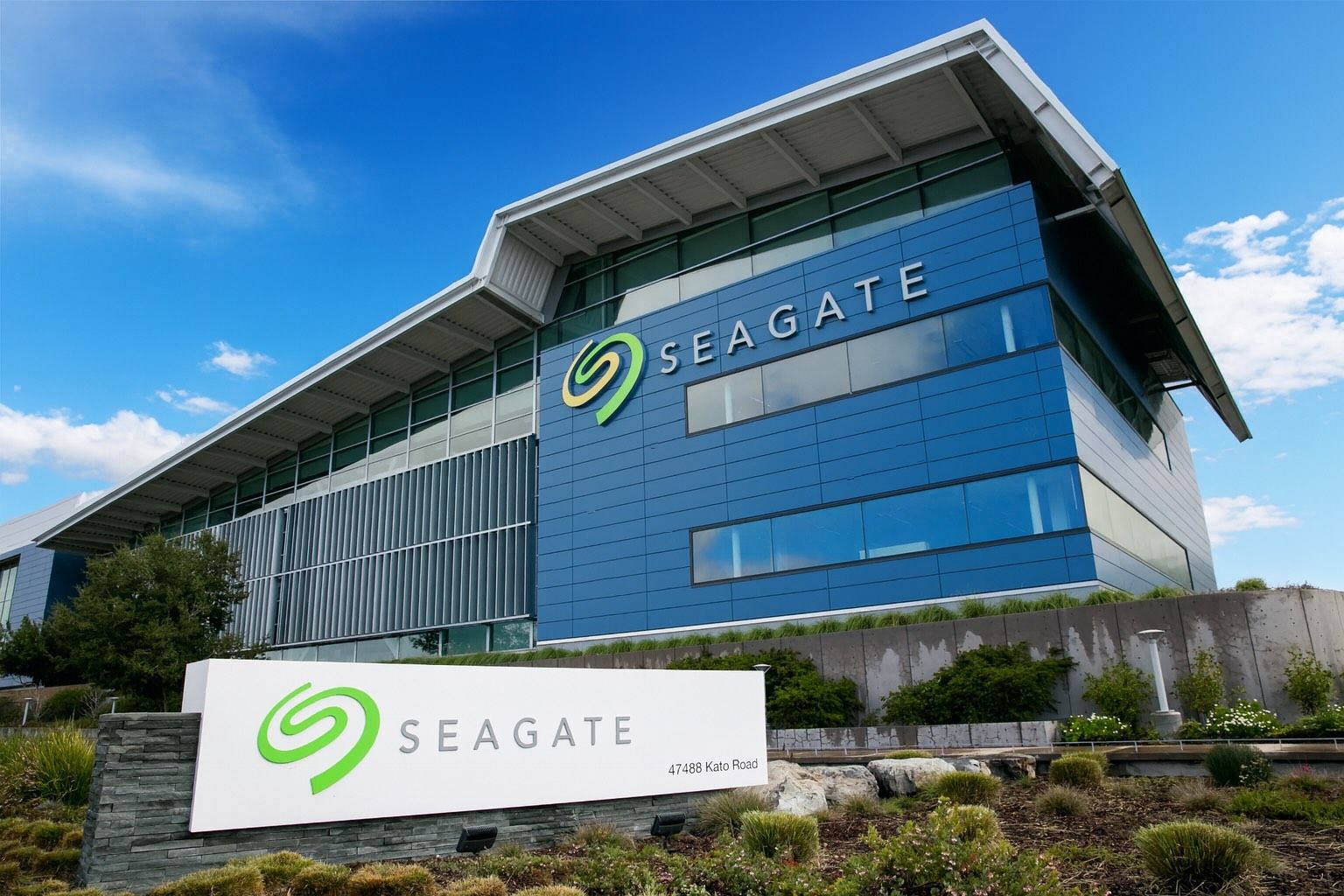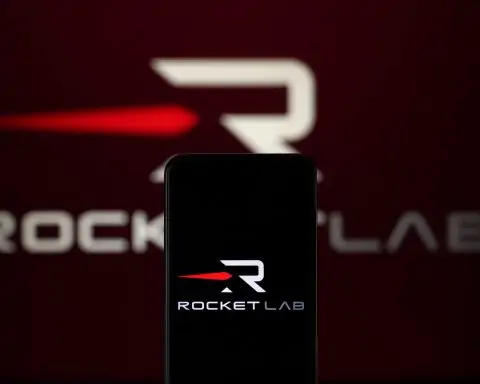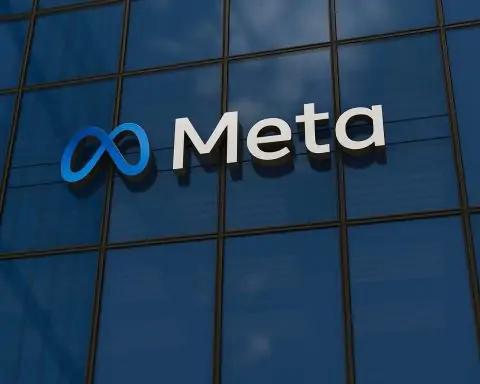- Stock Performance: Seagate Technology (NASDAQ: STX) closed at $223.00 on October 28, 2025, down 3.2% for the day [1]. However, shares jumped over 4% in after-hours trading on an earnings beat and are up roughly 160% year-to-date [2], making Seagate one of 2025’s top-performing tech stocks. Rival Western Digital (WDC) has climbed about 175% YTD [3] amid the same trend.
- Earnings Beat & Outlook: Seagate reported quarterly revenue of $2.63 billion, up ~21% year-on-year and about 3% above Wall Street forecasts [4]. Adjusted EPS came in at $2.61, topping estimates by 8–9% [5]. Buoyed by strong demand, Seagate raised its outlook: it guides next-quarter revenue to ~$2.7 billion (above the ~$2.66 billion consensus) and projects ~$2.75 EPS, also ahead of forecasts [6]. Executives cited robust orders from cloud and AI customers.
- AI-Fueled Demand: CEO Dave Mosley said surging data needs – from social media video to new AI applications – are “driving” booming storage demand [7]. Cloud providers are pouring billions into hardware for generative AI, and Seagate’s high-capacity drives are in “hot demand” for AI data centers [8]. This marks a sharp turnaround from the supply glut of recent years, as the AI boom normalizes storage investment.
- Analyst Bullishness: Wall Street experts are largely positive. Citigroup recently reiterated a Buy and hiked Seagate’s price target to $250 (from $215), and Evercore ISI lifted its target to $330 [9] – signaling confidence in further upside. Bank of America also boosted its target (to $255) in late September, citing “resilient” HDD pricing and strong AI-related orders. Analysts note “incrementally better sentiment” and stronger supply/demand dynamics for storage, supporting higher valuations [10].
- Industry & Competition:Data storage is a duopoly: Seagate and Western Digital dominate the hard disk drive market. Both stocks have more than doubled this year as investors bet on a multi-quarter upcycle [11]. Western Digital, which spun off its flash-memory arm earlier in 2025 [12], is likewise riding the wave of AI-driven demand. Seagate’s market cap is now about $49 billion [13] and the stock trades around 20× forward earnings, a premium to its 5-year average (~17×) [14]. Analysts say Seagate’s edge in next-gen HAMR drive technology (which packs more data per disk) gives it a leg up on Western Digital [15], potentially boosting margins and justifying that valuation.
Earnings Beat Lifts Shares and Guidance
Seagate’s latest results gave investors plenty to cheer. For the quarter ended in early October, the data-storage leader smashed expectations with $2.63 billion in sales (up 21% year-over-year) and $2.61 in adjusted earnings per share, well above analyst estimates of $2.55 billion and $2.40 respectively [16]. This “blowout” earnings beat reflects a sharp rebound in demand for Seagate’s hard disk drives (HDDs) after a tough period. “We saw broad strength across our portfolio, especially in high-capacity drives for AI,” CEO Dave Mosley noted on the results call (per the company’s release).
Even more encouraging was Seagate’s forward guidance. The company forecast revenue of about $2.7 billion next quarter, topping consensus ~$2.66 billion, and a profit of roughly $2.75 per share, ahead of the ~$2.62 expected [17]. Seagate is “betting on robust demand” from cloud providers that continue to invest heavily in AI infrastructure [18]. In fact, Seagate’s management has reinstated full-range guidance for the first time in years – a sign of confidence as supply-chain pressures ease and customers ramp up orders.
Investors reacted quickly. Although STX stock fell 3% during Tuesday’s session (ahead of earnings), it spiked more than 4% in after-hours trading once the strong results and outlook hit the wires [19] [20]. As of publication, Seagate’s stock is hovering around $233 in extended trade. Through Tuesday’s close, the stock had already surged about 162% in 2025 [21] – and the latest news suggests the rally may have more room to run.
“These numbers were strong across the board – a big beat-and-raise,” commented a CNBC market analyst, noting that Seagate’s year-over-year sales growth turned sharply positive after a slump last year. The company’s gross margins have also improved with higher utilization of factories. Seagate reported a non-GAAP gross margin of ~31.6% this quarter, up from ~28% a year ago, and it expects margins to further expand next quarter (helped by higher volumes and new cost efficiencies). Free cash flow also improved markedly, allowing Seagate to maintain its quarterly dividend and continue share buybacks, which income investors appreciate.
Riding the AI Storage Boom
Seagate’s stellar performance is being driven by a powerful tech trend: the explosive growth of data and the hardware needed to store it. The rise of artificial intelligence is fueling unprecedented demand for storage in data centers. Training advanced AI models (like generative AI systems for chatbots, image generation, etc.) requires massive datasets and high-speed access, translating into more and bigger drives.
Cloud giants such as Amazon, Microsoft, and Google are in the midst of multi-billion-dollar AI infrastructure expansions, and “Seagate, which supplies disk drives to store vast amounts of data, has benefited from this” trend, Reuters notes [22] [23]. In extended trading Tuesday, Seagate’s stock popped after the company explicitly credited AI hardware spending for its upbeat forecast.
“Demand for existing use cases such as social media video platforms as well as growth driven by new AI applications” is boosting shipments, CEO Dave Mosley said [24]. In other words, not only are cutting-edge AI projects driving orders, but everyday services like social networks, streaming video, and smartphones (which increasingly incorporate AI features) are also gobbling up storage. Seagate noted that the addition of AI capabilities in consumer devices is raising memory and storage requirements – a tailwind for its business in the PC/mobile segment [25].
Crucially, industry conditions have improved dramatically from a year or two ago. During the pandemic-era tech slowdown, storage suppliers faced a glut as customers worked through excess inventory. Now that oversupply has cleared, and “inventory levels have normalized”, cloud customers are back to ordering new drives to keep pace with data growth [26]. Seagate’s latest quarter was its sixth straight of sequential growth, marking a solid upcycle after the downturn. The company is guiding for ~16% year-on-year sales growth next quarter [27], and Wall Street expects double-digit growth to continue into 2026.
Industry analysts highlight a structural shift: the world’s appetite for data storage shows no sign of slowing. Bernstein Research notes that from 2013 to 2024, total storage capacity shipped (across both disk drives and flash memory) grew about 14% annually – but they expect that to re-accelerate to ~19% annually through 2030, thanks to richer digital content, stricter data retention policies, and AI’s data-intensive workloads [28]. Data center storage demand could expand even faster (~23% CAGR) as organizations build out AI training clusters [29]. This rising tide lifts both boats in the HDD industry.
Notably, Seagate and Western Digital form a near-duopoly in hard drives, after years of industry consolidation. This duopoly structure is fostering “stronger structural demand… and improved gross margin expectations” for suppliers [30]. In other words, with just two major players left, pricing has stabilized and each can operate more profitably. Both companies slashed costs during the downturn and are now benefiting as sales rebound. Seagate’s operating margin hit 26% this quarter [31], up from 18.6% a year ago – a remarkable jump reflecting both higher volumes and leaner operations.
Analyst Views: Optimism with a Note of Caution
Following Seagate’s dramatic run-up this year, the key question is: what comes next? Wall Street, for the most part, remains bullish that there’s further upside, though some urge caution on the stock’s valuation. The past few months have seen a flurry of analyst upgrades and target hikes for Seagate.
Just two weeks ago, Evercore ISI reaffirmed its positive view and jacked its price target up to $330 (from $160 previously) – a level ~40% above the latest price [32]. Around the same time, Citigroup reiterated a Buy rating and raised its target to $250 [33]. And in late September, Bank of America analysts boosted their target from $215 to $255, citing stronger-than-expected hard disk drive pricing and sustained cloud demand. Multiple firms have also lifted Western Digital’s targets (BofA now sees WDC at $141 [34]) as they grow more confident in the storage cycle.
Wall Street’s enthusiasm boils down to improved fundamentals. One brokerage note highlighted “solid supply/demand dynamics” and an “incrementally better sentiment” around data storage, after years of volatility [35]. Wells Fargo analysts, for instance, pointed to “stronger structural demand for nearline hard disk drives” (the high-capacity drives used in servers) and improved gross margin trends when they upped Seagate’s target to $240 [36]. In short, many analysts believe the current upcycle is real and driven by lasting trends (AI, cloud, video streaming) rather than just a transient blip.
Some experts also underscore Seagate’s technology advantage. The company has been a front-runner in developing HAMR (Heat-Assisted Magnetic Recording) drives – next-generation HDDs that use lasers to cram far more data onto each platter. HAMR drives can significantly increase storage densities, which is crucial for cloud customers needing to pack petabytes into data centers. “Both Seagate and Western Digital will benefit from strong HDD demand… but [Bernstein] favors Seagate due to its stronger position in HAMR technology,” one analyst report noted [37]. This edge could allow Seagate to capture market share and command higher prices for its cutting-edge drives. Indeed, Seagate began shipping 30+ terabyte HAMR drives in 2024, and analysts say this could entrench its leadership at the high end [38]. Evercore ISI’s team argues Seagate’s HAMR lead should drive higher gross margins and justify a premium valuation versus Western Digital [39].
That said, after a 160% year-to-date surge, Seagate’s stock is no longer cheap. The stock trades around 20 times forward earnings, above its 5-year historical average (~17×) [40]. Its dividend yield has compressed to about 2.5% despite the company maintaining payouts (the share price climbed faster). Some analysts warn that a lot of good news is already priced in. As Morningstar put it in a recent note, “Seagate’s valuation now bakes in a rosy scenario – any hiccup in AI spending or a swing in market sentiment could hit the stock.” The memory and storage industry is famously cyclical, and while AI is a strong tailwind, it’s not immune to broader economic factors. If tech capital expenditures slow down or if companies shift more to flash storage (SSDs) for certain tasks, demand for disk drives could moderate.
Seagate’s management remains confident but realistic. CEO Mosley has emphasized that while AI and cloud orders are robust, the company is “carefully managing supply chains” to avoid bottlenecks and is watchful of any macroeconomic clouds on the horizon [41]. He also acknowledged that competition isn’t standing still – Western Digital and new entrants are vying in the high-capacity storage arena. Western Digital’s recent flash memory spin-off (now trading as SanDisk) underscores its focus on core HDD and SSD markets, and any aggressive pricing moves by WDC or others could pressure industry profits if demand wavers [42]. For now, though, both major HDD vendors appear disciplined, and the market is expanding fast enough for each to benefit.
Outlook: Can Seagate Keep Spinning to New Highs?
Seagate’s epic rally in 2025 has been fueled by a perfect confluence of factors: breakthrough AI-driven demand, improved industry structure, and the company’s own execution in delivering next-gen products. Year-to-date, Seagate shares have more than doubled, vastly outperforming the broader Nasdaq (+23% YTD) [43]. Western Digital’s stock similarly hit multi-year highs, and even SanDisk (SNDK) – the flash memory business WD spun off in February – has surged ~250% since its listing [44], reflecting optimism across the storage spectrum.
The key question for investors is whether Seagate can sustain this momentum. Bulls believe we are in the early innings of an AI-centered upgrade cycle that could last several years. Corporate and cloud budgets for AI infrastructure are “stronger for longer” – as one Investopedia piece noted – meaning data center spending might stay elevated well into 2026 [45]. A Morgan Stanley analyst recently called Seagate a prime play on “AI data proliferation,” arguing that the flood of digital information will keep storage devices in high demand [46]. Morgan Stanley’s team was impressed enough to raise its price target to $265 and declared the company’s outlook the “most optimistic in years,” according to TS2 Technology’s market recap [47].
Skeptics counter that such growth rates will inevitably moderate. They caution that competition from solid-state drives (SSDs) – based on flash memory – could re-emerge if flash prices drop. (Enterprise buyers sometimes substitute SSDs for HDDs in performance-sensitive applications, though HDDs still hold a big cost advantage for bulk storage.) Another risk is macroeconomic: a slowdown in tech spending or a cutback in cloud capital expenditures (for example, if higher interest rates or economic uncertainty make firms tighten their belts) could dampen the feverish demand Seagate is currently enjoying.
For now, however, the company and its shareholders have the wind at their backs. “But for now, the trend is Seagate’s friend,” one analysis quipped, noting that investors clearly see Seagate as “a primary beneficiary of the digital data deluge.” As long as the world’s hunger for storage keeps climbing – and AI is ensuring that – Seagate’s drives will be spinning all the way to the bank, [48] potentially rewarding investors further.
Bottom Line: Seagate’s stock has ridden the AI hardware boom to stunning heights in 2025, and its latest earnings show fundamental strength backing up the hype. The company’s upbeat guidance and the chorus of bullish analysts suggest there may be more chapters to this growth story. Still, with the stock near record levels, investors will be watching closely for any signs of cooling demand. For now, Seagate is at the center of a tech resurgence – a once-“boring” storage supplier now turned market star – and many experts believe its run isn’t over yet.
Sources: Seagate earnings and guidance details [49] [50]; CEO and industry commentary [51] [52]; analyst targets and reactions [53] [54]; YTD performance and valuation [55] [56]; TS2.tech market analysis [57] [58]; Western Digital spin-off info [59].
References
1. stockanalysis.com, 2. www.tradingview.com, 3. www.tradingview.com, 4. markets.chroniclejournal.com, 5. markets.chroniclejournal.com, 6. sundayguardianlive.com, 7. sundayguardianlive.com, 8. ts2.tech, 9. markets.chroniclejournal.com, 10. www.owler.com, 11. ts2.tech, 12. www.westerndigital.com, 13. markets.chroniclejournal.com, 14. www.tradingview.com, 15. www.investing.com, 16. ca.investing.com, 17. sundayguardianlive.com, 18. sundayguardianlive.com, 19. stockanalysis.com, 20. sundayguardianlive.com, 21. www.tradingview.com, 22. sundayguardianlive.com, 23. sundayguardianlive.com, 24. sundayguardianlive.com, 25. sundayguardianlive.com, 26. sundayguardianlive.com, 27. markets.chroniclejournal.com, 28. www.investing.com, 29. www.investing.com, 30. www.owler.com, 31. markets.chroniclejournal.com, 32. markets.chroniclejournal.com, 33. markets.chroniclejournal.com, 34. swingtradebot.com, 35. www.owler.com, 36. www.owler.com, 37. www.investing.com, 38. ts2.tech, 39. www.investing.com, 40. www.tradingview.com, 41. ts2.tech, 42. ts2.tech, 43. www.tradingview.com, 44. www.owler.com, 45. ts2.tech, 46. ts2.tech, 47. ts2.tech, 48. ts2.tech, 49. ca.investing.com, 50. sundayguardianlive.com, 51. sundayguardianlive.com, 52. sundayguardianlive.com, 53. markets.chroniclejournal.com, 54. www.owler.com, 55. www.tradingview.com, 56. www.investing.com, 57. ts2.tech, 58. ts2.tech, 59. www.westerndigital.com







